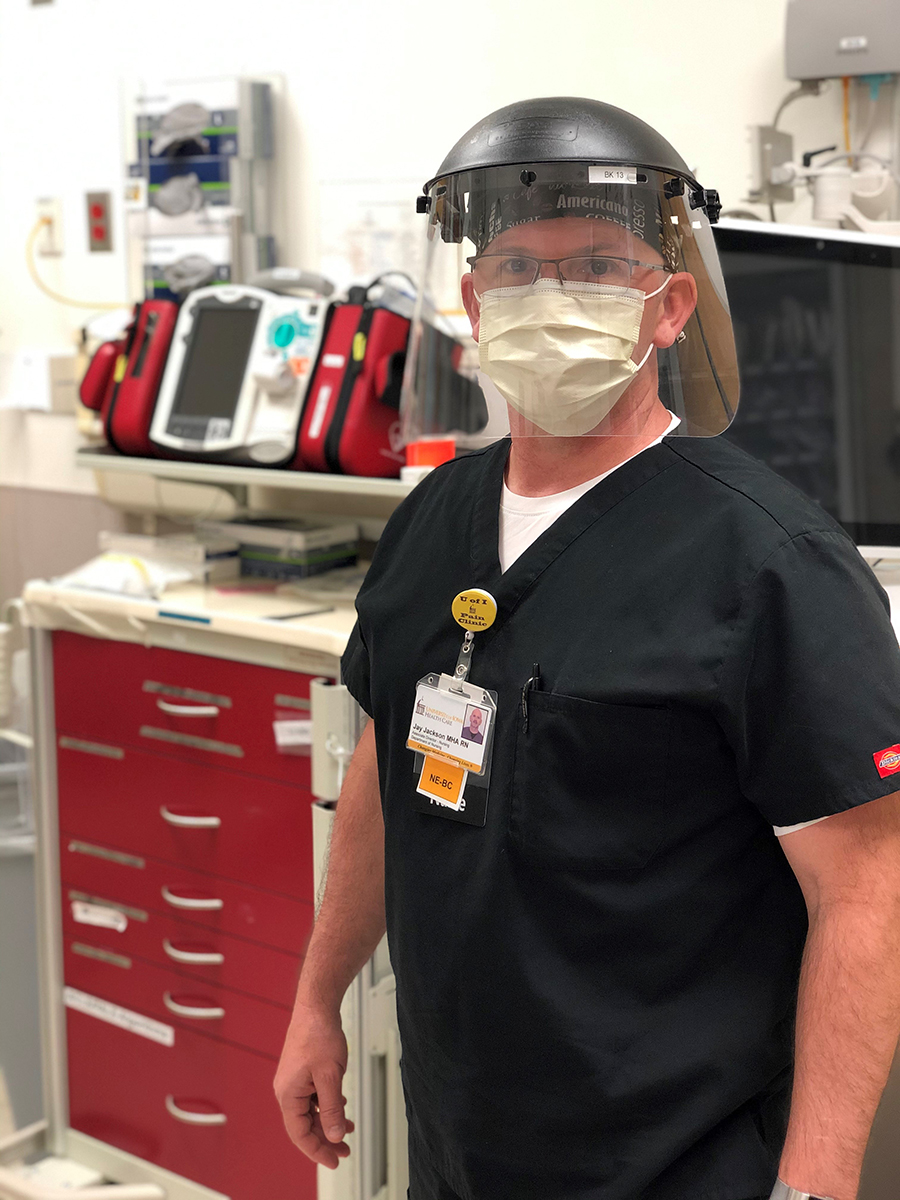‘We’re ready to handle anything.’ How our Emergency Department is safely treating all patients in need of care
Jay Jackson, RN, the associate director of nursing services, says the Emergency Department at the University of Iowa Hospitals & Clinics is always ready to handle any emergency that comes through its doors—from heart attacks, strokes, and traumatic injuries to suspected COVID-19 patients.
Jay Jackson, RN, associate director of nursing services, is a firm believer that no one should be scared to come to the Emergency Department if they need care. “We do everything possible to protect patients and ourselves,” he says.
“This is what we do. We’re ready to handle anything,” he says. “We’ve trained for it, and we’re prepared.”
Even before the first COVID-19 patient arrived at the hospital, teams had plans in place to dedicate specialized treatment rooms and separate patients potentially having an infectious disease from others needing to be seen in the Emergency Department.

“When the first cases of coronavirus started appearing in the United States, we activated our Hospital Incident Command System and started meeting multiple times a day to review protocols, identify best practices, and gather the needed safety equipment for staff,” explains Jackson. “We set up negative pressure treatment rooms in the Emergency Department for any patients suspected of COVID-19, and the hospital has dedicated COVID-19 inpatient units, moving all other patients to other areas of the hospital.”
Right procedures in place
Because of extensive preparations and years of response drills, hundreds of staff were already trained when the first COVID-19 patient was transported to the hospital.
“We were notified by the ambulance crew that they were 15-20 minutes away with a patient that likely had COVID-19, and we put everything into motion,” recalls Sarah Wheeler, RN, one of the first nurses to see the patient. “By the time the ambulance pulled up to our doors, we were all gowned up and wearing protective gear, including face shields, and I remember that our adrenaline started flowing as we waited for the patient to be brought inside.”
For Wheeler, that day was like a baptism by fire. She had recently graduated from nursing school, but she was confident she was ready, thanks to extensive training and an entire department of experienced nurses and physicians beside her. Hospital epidemiologists and senior leadership were also in the Emergency Department.
“We were all a bit nervous, but we had the right procedures in place, and we followed the guidelines,” says Wheeler. “We were able to care for that patient as well as others needing emergency care who didn’t have COVID-19.”
COVID-19 screening at a separate location
Sarah Wheeler, RN, was one of the first nurses to see a COVID-19 patient in the Emergency Department.
“We’re used to thinking on our feet and moving fast,” says Wheeler. “This is the place to come if you need help.”
The day before the first patient with COVID-19 was admitted to our hospital, UI Hospitals & Clinics established a large telemedicine program to help screen patients. If patients with non-life threatening respiratory issues needed to be seen, the hospital also set up a respiratory clinic as an initial triage location.
“This clinic has been huge for minimizing the ongoing impact to the Emergency Department during all of this,” says Jackson. “That clinic, which is at a separate location, sometimes sees more than 150 patients a day to be tested for COVID-19. If it hadn’t been established, many of those patients would have come to the Emergency Department.”
For patients who are confirmed with COVID-19, but who can remain at home with milder symptoms, the hospital launched a multidisciplinary Home Treatment Team that includes nurses, physicians, pharmacists, and support staff, all of whom use twice-daily telemedicine calls to provide ongoing monitoring and care.
Safety is a priority
Within the Emergency Department itself, several practices have been implemented to keep patients and staff safe.
“We have restricted visitors so that we can minimize the risk of exposure and conducted ongoing staff training to properly use personal protective equipment,” says Jackson. “And we continue to discuss and update our protocols as we receive new information from the CDC and from hospitals across the country.”
Emergency medicine physician Nick Mohr, MD, MS, agrees.
“We’ve implemented so many changes in a very short period of time that are going to be used as best practices long after this pandemic is over,” he says. “It seems like every day, we are coming up with new solutions to change — for the better — the way we take care of people tomorrow.”
The one message the team wants to send to any patient needing emergency care, with or without suspected COVID-19, is that the Emergency Department is safe and the team can handle any emergencies.
“We’re used to thinking on our feet and moving fast,” says Wheeler. “This is the place to come if you need help.”
Adds Jackson, “No one should be scared to come to the ER if they need emergency care. We do everything possible to protect patients and ourselves. We’re ready.”